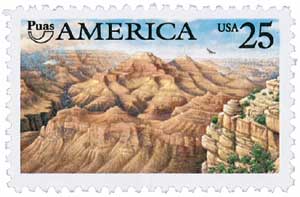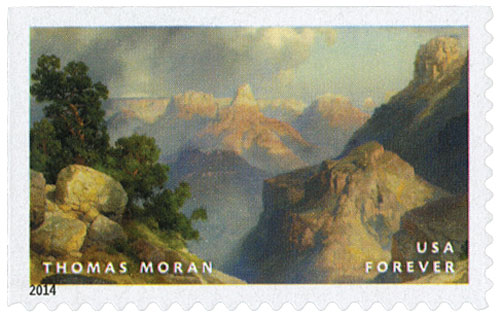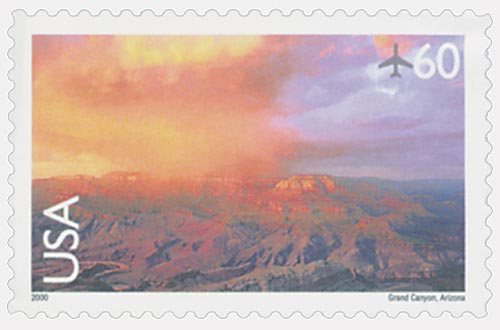
# 3183h FDC - 1998 32c Celebrate the Century - 1910s: Grand Canyon
32¢ Grand Canyon National Park
Celebrate the Century – 1910s
City: Washington, DC
Quantity: 12,533,000
Printed By: Ashton-Potter (USA) Ltd
Printing Method: Lithographed
Perforations: 11.5
Color: Multicolored
Grand Canyon National Park Established

On February 26, 1919, Woodrow Wilson signed legislation establishing the Grand Canyon National Park.
The history of the Grand Canyon began up to two billion years ago when some of the oldest rock in the canyon was lifted to create a great mountain range nearly six miles high. Over millions of years, the land was raised, eroded and raised again several times. Then, about six million years ago, the Colorado River began carving through the rock, creating the vast canyon.

Beginning about 11,000 years ago and lasting until the end of the last ice age, the Paleo-Indians roamed the Grand Canyon area hunting large game. Over thousands of years, these people developed into the Archaic tribes. Some of the noted tribes to inhabit the canyon were the Hohokam, Mogollon, Anasazi, and Tusayan.

Some of the earliest Americans to enter the Grand Canyon region were trappers and mountain men led by Indian guides. Likely, one of the first to see the canyon was James Ohio Pattie, who reached the area in 1826 with a group of fur trappers and mountain men. In the coming years, more and more Americans returned from the West with tales of this awe-inspiring canyon, so the U.S. Department of War sent an expedition to the area. The goal was to study its natural resources, find railroad routes to the West Coast, and determine the possibility of creating an up-river navigation route from the Gulf of California. Joseph Ives led the two-month, 350-mile expedition. Putting aside his impressions of the canyon’s beauty, Ives reported that it and the surrounding area were “altogether valueless” and that his expedition would be “the last party of whites to visit this profitless locality.”

In the mid-1800s, valuable minerals were discovered in the canyon and its surrounding areas, leading thousands to come and stake their claim. The problem many did not initially realize was how difficult it would be to get their discoveries out of the canyon. Over time, many gave up and moved on, but others saw the real future in the canyon – tourism. One such person was John Hance, who became the canyon’s first settler. He promoted mining, built and improved trails, and opened a hotel. Around the same time, another settler named William Wallace Bass created more roads into the canyon and trails within it than any other pioneer of the area.

While some sought to profit from the canyon, others realized the need to protect it. Senator Benjamin Harrison was the first person to introduce legislation calling for the creation of Grand Canyon National Park. His 1882 bill failed and he tried again unsuccessfully in 1883 and 1886. It was not until after Harrison became President that he was able to provide some protection to the area. It was established as the Grand Canyon Forest Reserve in 1893, though some mining and logging was still allowed.

Theodore Roosevelt visited the Grand Canyon in 1903 and was in awe at its beauty. But it would be another three years before he made any progress to further protect it. Roosevelt took the first step in 1906 when he declared it the Grand Canyon Game Preserve, which reduced livestock grazing. He continued to fight for a national park, but was blocked by landowners and mining claim holders. Roosevelt made some progress in 1908 when he established the canyon and surrounding area – a total of more than 800,000 acres – as a national monument. Meanwhile, Arizona officials continued to promote the idea of a Grand Canyon National Park, but their bills were defeated several times between 1910 and 1911.
In 1912, Arizona became America’s 48th state, and four years later the National Park Service was officially formed. Both of these events helped the process of establishing the Grand Canyon as a national park. Finally, on February 26, 1919, President Woodrow Wilson signed the legislation officially establishing the canyon as a national park. The timing was perfect, as it put an end to proposals to dam the Colorado River. It also forbid private development and granted the Fred Harvey Company the only rights to develop commercial businesses.
32¢ Grand Canyon National Park
Celebrate the Century – 1910s
City: Washington, DC
Quantity: 12,533,000
Printed By: Ashton-Potter (USA) Ltd
Printing Method: Lithographed
Perforations: 11.5
Color: Multicolored
Grand Canyon National Park Established

On February 26, 1919, Woodrow Wilson signed legislation establishing the Grand Canyon National Park.
The history of the Grand Canyon began up to two billion years ago when some of the oldest rock in the canyon was lifted to create a great mountain range nearly six miles high. Over millions of years, the land was raised, eroded and raised again several times. Then, about six million years ago, the Colorado River began carving through the rock, creating the vast canyon.

Beginning about 11,000 years ago and lasting until the end of the last ice age, the Paleo-Indians roamed the Grand Canyon area hunting large game. Over thousands of years, these people developed into the Archaic tribes. Some of the noted tribes to inhabit the canyon were the Hohokam, Mogollon, Anasazi, and Tusayan.

Some of the earliest Americans to enter the Grand Canyon region were trappers and mountain men led by Indian guides. Likely, one of the first to see the canyon was James Ohio Pattie, who reached the area in 1826 with a group of fur trappers and mountain men. In the coming years, more and more Americans returned from the West with tales of this awe-inspiring canyon, so the U.S. Department of War sent an expedition to the area. The goal was to study its natural resources, find railroad routes to the West Coast, and determine the possibility of creating an up-river navigation route from the Gulf of California. Joseph Ives led the two-month, 350-mile expedition. Putting aside his impressions of the canyon’s beauty, Ives reported that it and the surrounding area were “altogether valueless” and that his expedition would be “the last party of whites to visit this profitless locality.”

In the mid-1800s, valuable minerals were discovered in the canyon and its surrounding areas, leading thousands to come and stake their claim. The problem many did not initially realize was how difficult it would be to get their discoveries out of the canyon. Over time, many gave up and moved on, but others saw the real future in the canyon – tourism. One such person was John Hance, who became the canyon’s first settler. He promoted mining, built and improved trails, and opened a hotel. Around the same time, another settler named William Wallace Bass created more roads into the canyon and trails within it than any other pioneer of the area.

While some sought to profit from the canyon, others realized the need to protect it. Senator Benjamin Harrison was the first person to introduce legislation calling for the creation of Grand Canyon National Park. His 1882 bill failed and he tried again unsuccessfully in 1883 and 1886. It was not until after Harrison became President that he was able to provide some protection to the area. It was established as the Grand Canyon Forest Reserve in 1893, though some mining and logging was still allowed.

Theodore Roosevelt visited the Grand Canyon in 1903 and was in awe at its beauty. But it would be another three years before he made any progress to further protect it. Roosevelt took the first step in 1906 when he declared it the Grand Canyon Game Preserve, which reduced livestock grazing. He continued to fight for a national park, but was blocked by landowners and mining claim holders. Roosevelt made some progress in 1908 when he established the canyon and surrounding area – a total of more than 800,000 acres – as a national monument. Meanwhile, Arizona officials continued to promote the idea of a Grand Canyon National Park, but their bills were defeated several times between 1910 and 1911.
In 1912, Arizona became America’s 48th state, and four years later the National Park Service was officially formed. Both of these events helped the process of establishing the Grand Canyon as a national park. Finally, on February 26, 1919, President Woodrow Wilson signed the legislation officially establishing the canyon as a national park. The timing was perfect, as it put an end to proposals to dam the Colorado River. It also forbid private development and granted the Fred Harvey Company the only rights to develop commercial businesses.













